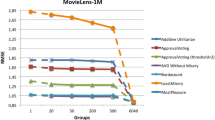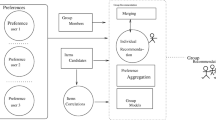Abstract
A recommender system suggests items to users by predicting what might be interesting for them. The prediction task has been highlighted in the literature as the most important one computed by a recommender system. Its role becomes even more central when a system works with groups, since the predictions might be built for each user or for the whole group. This paper presents a deep evaluation of three approaches, used for the prediction of the ratings in a group recommendation scenario in which groups are detected by clustering the users. Experimental results confirm that the approach to predict the ratings strongly influences the performance of a system and show that building predictions for each user, with respect to building predictions for a group, leads to great improvements in the accuracy of the recommendations.











Similar content being viewed by others
Explore related subjects
Discover the latest articles, news and stories from top researchers in related subjects.References
Adomavicius, G., & Tuzhilin, A. (2005). Toward the next generation of recommender systems: A survey of the state-of-the-art and possible extensions. IEEE Transactions on Knowledge and Data Engineering, 17(6), 734–749.
Amatriain, X., Jaimes, A., Oliver, N., Pujol, J.M. (2011). Data mining methods for recommender systems. In: Ricci, F., Rokach, L., Shapira, B., Kantor, P.B. (Eds.) In Recommender Systems Handbook (pp. 39–71). Springer: Boston.
Boratto, L., & Carta, S. (2011). State-of-the-art in group recommendation and new approaches for automatic identification of groups. In Information Retrieval and Mining in Distributed Environments (pp. 1–20). Springer: Berlin Heidelberg.
Boratto, L., & Carta, S. (2013). Exploring the ratings prediction task in a group recommender system that automatically detects groups. In IMMM 2013, The Third International Conference on Advances in Information Mining and Management (pp. 36–43).
Boratto, L., & Carta, S. (2014). Modeling the preferences of a group of users detected by clustering: A group recommendation case-study. In Proceedings of the 4th International Conference on Web Intelligence, Mining and Semantics (WIMS14), WIMS ’14 (pp. 16:1–16:7). ACM: New York. doi:10.1145/2611040.2611073.
Boratto, L., Carta, S., Chessa, A., Agelli, M., Clemente, M.L. (2009). Group recommendation with automatic identification of users communities. In Proceedings of the 2009 IEEE/WIC/ACM International Joint Conference on Web Intelligence and Intelligent Agent Technology - Volume 03, WI-IAT ’09 (pp. 547–550). IEEE Computer Society: Washington, DC. doi:10.1109/WI-IAT.2009.346.
Boratto, L., Carta, S., Satta, M. (2010). Groups identification and individual recommendations in group recommendation algorithms. In J. Picault, D. Kostadinov, P. Castells, A. Jaimes (Eds.) Practical Use of Recommender Systems, Algorithms and Technologies 2010, CEUR Workshop Proceedings, vol. 676, http://ceur-ws.org/Vol-676/paper4.pdf.
Chen, Y., & Pu, P. (2013). Cofeel: Using emotions to enhance social interaction in group recommender systems. In Alpine Rendez-Vous (ARV) 2013 Workshop on Tools and Technology for Emotion-Awareness in Computer Mediated Collaboration and Learning.
Crossen, A., Budzik, J., Hammond, K.J. (2002). Flytrap: intelligent group music recommendation. In Proceedings of the 7th international conference on Intelligent user interfaces, IUI ’02 (pp. 184–185). ACM: New York.
Desrosiers, C., & Karypis, G. (2011). A comprehensive survey of neighborhood-based recommendation methods. In Recommender Systems Handbook (pp. 107–144). Springer: Berlin.
Goren-Bar, D., & Glinansky, O. (2004). Fit-recommend ing tv programs to family members. Computers & Graphics, 28(2), 149–156.
Herlocker, J., Konstan, J., Borchers, A., Riedl, J. (1999). An algorithmic framework for performing collaborative filtering. In Research and Development in Information Retrieval. American Association of Computing Machinery.
Jameson, A. (2004). More than the sum of its members: challenges for group recommender systems. In Proceedings of the working conference on Advanced visual interfaces (pp. 48–54). ACM Press.
Jameson, A., & Smyth, B. (2007). Recommendation to groups. In The Adaptive Web, Methods and Strategies of Web Personalization (pp. 596–627). Springer.
Jung, J.J. (2012). Attribute selection-based recommendation framework for short-head user group: An empirical study by movielens and imdb. Expert Systems with Applications, 39(4), 4049–4054.
Kanungo, T., Mount, D.M., Netanyahu, N.S., Piatko, C.D., Silverman, R., Wu, A.Y. (2002). An efficient k-means clustering algorithm: Analysis and implementation. IEEE Transaction Pattern Analysis Machinist Intelligence, 24, 881–892.
MacQueen, J.B. (1967). Some methods for classification and analysis of multivariate observations. In Proceedings of the 5th Berkeley Symposium on Mathematical Statistics and Probability (vol. 1, pp. 281–297). University of California Press.
Manca, M., Boratto, L., Carta, S. (2014a). Design and architecture of a friend recommender system in the social bookmarking domain. In Proceedings of the Science and Information Conference 2014 (pp. 838–842).
Manca, M., Boratto, L., Carta, S. (2014b). Mining user behavior in a social bookmarking system- a delicious friend recommender system. In Proceedings of the 3rd International Conference on Data Management Technologies and Applications (DATA 2014) (pp. 331–338).
Masthoff, J. (2011). Group recommender systems: Combining individual models. In Recommender Systems Handbook (pp. 677–702). Springer: Berlin.
McCarthy, J. (2002). Pocket Restaurant Finder: A situated recommender system for groups. In Workshop on Mobile Ad-Hoc Communication at the 2002 ACM Conference on Human Factors in Computer Systems.
McCarthy, J.F., & Anagnost, T.D. (1998). Musicfx: An arbiter of group preferences for computer supported collaborative workouts. In S.E. Poltrock, & J. Grudin (Eds.) Proceedings of the ACM 1998 Conference on Computer Supported Cooperative Work, CSCW ’98, November 14-18, 1998 (pp. 363–372). ACM: Seattle, USA.
McCarthy, K., Salamó, M., Coyle, L., McGinty, L., Smyth, B., Nixon, P. (2006). Cats: A synchronous approach to collaborative group recommendation. In: G. Sutcliffe, & R. Goebel (Eds.) Proceedings of the Nineteenth International Florida Artificial Intelligence Research Society Conference, Melbourne Beach, May 11-13, 2006 (pp. 86–91). AAAI Press: Florida, USA.
O’Connor, M., Cosley, D., Konstan, J.A., Riedl, J. (2001). Polylens: A recommender system for groups of user. In Proceedings of the Seventh European Conference on Computer Supported Cooperative Work (pp. 199–218). Kluwer.
Ricci, F., Rokach, L., Shapira, B. (2011). Introduction to recommender systems handbook. In Recommender Systems Handbook (pp. 1–35). Springer: Berlin.
Schafer, J.B., Frankowski, D., Herlocker, J.L., Sen, S. (2007). Collaborative filtering recommender systems. In The Adaptive Web, Methods and Strategies of Web Personalization (pp. 291–324). Springer: Berlin.
Stettinger, M., & Felfernig, A. (2014). Choicla: Intelligent decision support for groups of users in context of personnel decisions. In Proceedings of the ACM RecSys’2014 IntRS Workshop (pp. 28–32).
Yu, Z., Zhou, X., Hao, Y., Gu, J. (2006). Tv program recommendation for multiple viewers based on user profile merging. User Modeling and User-Adapted Interaction, 16(1), 63–82.
Zhiwen, Y., Xingshe, Z., Daqing, Z. (2005). An adaptive in-vehicle multimedia recommender for group users. In Proceedings of the 61st Semiannual Vehicular Technology Conference (vol. 5, pp. 2800–2804).
Author information
Authors and Affiliations
Corresponding author
Additional information
This work is partially funded by Regione Sardegna under project SocialGlue, through PIA - Pacchetti Integrati di Agevolazione “Industria Artigianato e Servizi” (annualità 2010).
Rights and permissions
About this article
Cite this article
Boratto, L., Carta, S. The rating prediction task in a group recommender system that automatically detects groups: architectures, algorithms, and performance evaluation. J Intell Inf Syst 45, 221–245 (2015). https://doi.org/10.1007/s10844-014-0346-z
Received:
Revised:
Accepted:
Published:
Issue Date:
DOI: https://doi.org/10.1007/s10844-014-0346-z




